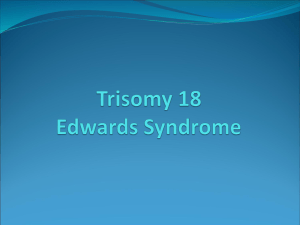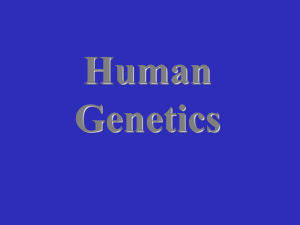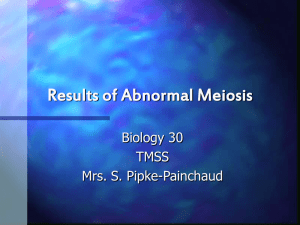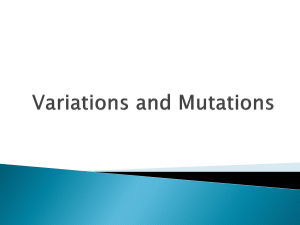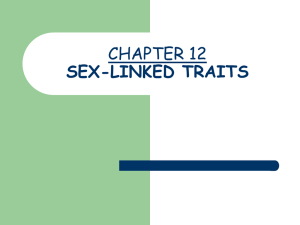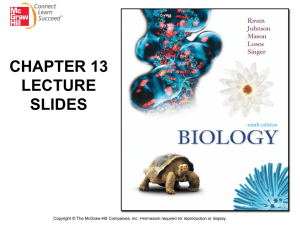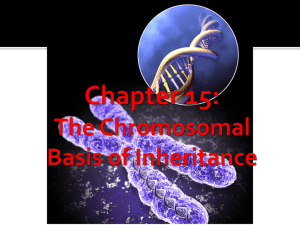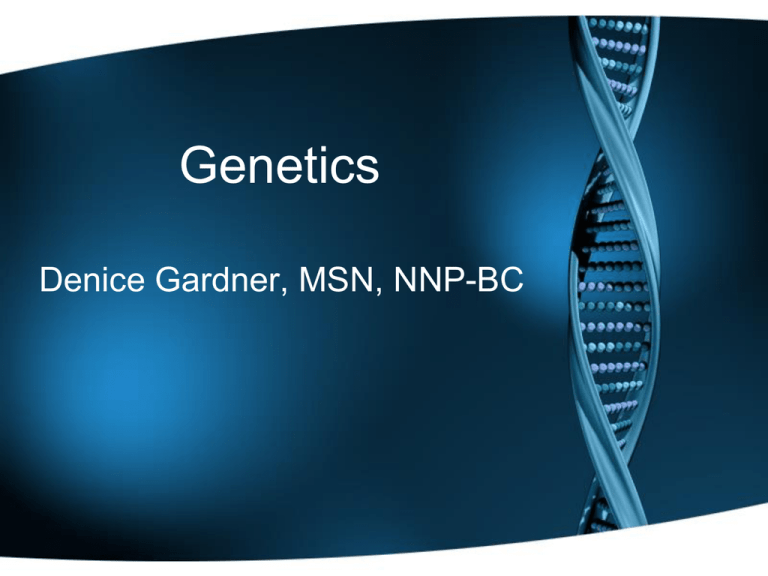
Genetics
Denice Gardner, MSN, NNP-BC
Objectives
Discuss genetics and its affects on the
newborn
Genetics
• Pictures included in presentation were
obtained from the Mosby’s Nursing
Consult web site
• Graphics used in presentation were
created by the author
Terminology
Genetics- study of heredity
Chromosome- structural element in a cell
that contains the genes and all the genetic
information; human cells have 23 pairs of
chromosomes
DNA- double-stranded nucleotide that
carries genetic material
Gene- segments of the DNA that are
responsible for inherited traits; contain the
“blueprint for everything that will make “you”
Terminology
Allele- variations in a gene; segregates
during meiosis; receive only one pair
from each parent; only 2 alleles can be
present in one person
Autosome- one of the 22 chromosomes
that do NOT determine the sex of a
person
Sex chromosome- the X & Y
chromosome that determines the sex of a
person
Terminology
Gamete- one of the 2 cells that joins
together during sexual reproduction to
create a new being
Genotype- genetic make-up of a person
Phenotype- biochemical, physiologic, &
morphologic characteristics of a person
(hair color, skin type, etc.) & is
determined by his/her genotype and
environment
Terminology
Haploid- number of chromosomes in a
gamete; half the number of chromosomes in
a person, 23 chromosomes
Diploid- contains a set of maternal &
paternal chromosomes to equal 46 total
chromosomes
Locus- location of the gene in the
chromosome
Penetrance- degree to which an inherited
trait will be expressed in a person
Dominant & Recessive Genes
Dominant- expressed & transmitted even if
only ONE parent has the gene
Recessive- expressed only when BOTH
parents have the gene
Homozygous- two identical alleles for a
particular gene (one from each parent)
Heterozygous- two different alleles for a
particular gene
Possible Combinations
Both can be dominant (AA)
Both can be recessive (aa)
One can be dominant & one can be
recessive (Aa)
Autosomal Dominant
Appears in every generation without
skipping
Either parent can pass the gene on to their
children
Risk for affected individuals to have affected
children is 50% with every pregnancy
If 2 affected parents mate, 75% of their
children will be affected
Unaffected individuals do NOT have
affected children
Trait is found equally in males and females
Autosomal Dominant
Affected
(Aa)
Normal
(aa)
Normal
(aa)
Affected
(Aa)
Affected
(Aa)
Normal
(aa)
Autosomal Recessive
Expressed only when both parents transmits
it to their offspring
Alternates generations
If 2 affected people mate, all children with
be affected
If 2 carriers mate, the risk of having an
affected offspring is 25%
If a carrier & an affected person mate, the
risk of having an affected offspring is 50%
Risk of an unaffected carrier having a child
who is a carrier is 50% with each pregnancy
Autosomal Recessive
Carrier
(Aa)
Normal
(AA)
Heterozygous
(Aa)
Heterozygous
(Aa)
Carrier
(Aa)
Affected
(aa)
X-Linked Dominant
Female children of affected males are ALL
affected
Male children of affected males are
unaffected
Trait appears in every generation
All children of affected females MAY be
affected
X-Linked dominant problems affect twice as
many females as males
X-Linked Dominant
Normal
Son (XY)
Affected
Daughter
(XX)
Normal
Mom (XX)
Affected
Dad (XY)
Normal
Son (XY)
Affected
Daughter
(XX)
Normal
Daughter
(XX)
Affected
Son (XY)
Affected
Mom (XX)
Normal
Dad (XY)
Affected
Daughter
(XX)
Normal
Son (XY)
X-Linked Recessive
Only Male children are affected. (Female
may be affected if mother is a carrier and
father is affected)
Traits cannot be transmitted from father
to son because the father only
contributes the Y chromosome
Transmission of the trait occurs from
father to all daughters (who will be
carriers)
X-Linked Recessive
Heterozygous females transmit the gene
to half of their sons, who will be affected,
& to half their daughters, who will be
carriers
Transmission is horizontal among males
of the same generation & then skips a
generation
Carrier females transmit the disorder
X-Linked Recessive
Normal
Son
(XY)
Carrier
Daughter
(XX)
Normal
Mom (XX)
Affected
Dad (XY)
Normal
Son (XY)
Carrier
Daughter
(XX)
Carrier
Daughter
(XY)
Normal
Son
(XY)
Carrier
Mom
(XY)
Normal
Dad (XY)
Affected
Son (XY)
Normal
Daughter
(XX)
Chromosomal Defects: Abnormal Number
Polyploidy- contains more than 2 sets of
chromosomes, showing multiples of the
haploid number; usually dies as embryos
or fetuses
Nonmultiples- designated by the suffix
“-somy”
Monosomy- one less than the diploid
number (45 chromosomes)
Trisomy- one more than the haploid
number (47 chromosomes)
Chromosome Defects: Abnormal Number
CausesNondisjunction- failure of paired
chromosomes to separate during cell
division; most common cause of all
chromosome disorders
Chromosome lag- failure of a chromosome
to travel to the correct daughter cell
Anaphase lag- failure of a chromosome or
chromatin to be incorporated into one of the
daughter nuclei following cell division as a
result of delayed movement during
anaphase
:
Chromosomal Defects: Abnormal
Number
Mosaicism:
Nondisjunction of an anaphase lag
that occurs during cell division after
fertilization
Cells within the same person that
have different genetic make-up
Chromosomal Defects: Abnormal
Structure
Deletion- loss of part of a chromosome
Translocations- displacement of part of a
chromosome to an abnormal site, whether
on another chromosome or in the wrong
position on the same chromosome
Polygenic effects- type of inheritance in
which a trait is dependent on many different
gene pairs with cumulative effects
Chromosome Defects: Abnormal
Structure
Environmental influences- nutrition, drugs, &
living environment (radiation, pollution,
bacteria, virus) that affect the genetic makeup & developing embryo while in utero
Duplication- duplication of an area of the
DNA that contain contains a gene; results in
mutations that have no deleterious affects
on a person
Chromosomal Defects: Abnormal
Structure
Inversion- area of a chromosome breaks off
and then reattaches itself in the opposite
direction
Nonreciprocal translocation- one-way
transfer of genes from one chromosome to
another
Chromosomal Defects: Abnormal
Structure
Basic Generalizations
Loss of an entire chromosome is
usually incompatible with life
One X chromosome is necessary for
life & development
If the Y-chromosome is missing, life &
development may continue but will
follow female pathways
Chromosomal Defects: Abnormal
Structure
Extra entire chromosomes,
translocations of extra chromatin
material, & insertion of extra chromatin
material are often compatible with life
& development
Multiple congenital structural defects
are present when gross aberrations
are present
Prenatal Testing
Alpha-Fetoprotein Test (AFP)
Usually done at 16-18 weeks gestation
Is a screening test, not a diagnostic
test
If abnormal, ultrasound should be
obtained
Prenatal Testing
Elevated AFP may indicate
Greater gestational age than expected
Multiple gestation
Risk of neonatal complications,
including spontaneous abortion, PTL,
or IUGR
Fetal structural defects: neural tube,
abdominal wall, esophageal or
intestinal obstruction, or renal
anomalies
Prenatal Testing
Multiple Marker Screen (“Quad Screen”)
Measures AFP, hCG, unconjugated
estriol (uE3), & dimeric inhibin-A (DIA)
Useful in detecting conditions like
trisomies
Usually done between 15-20 weeks
gestation
If, abnormal, ultrasound should be
obtained
Prenatal Testing
Ultrasonography- uses high-frequency
sound waves to display sectional planes of
the uterine contents on a monitor
Recommended by 16-20 weeks of age
for gestational age verification &
assessment
Used to detect abnormalities of the
fetus, placenta, amniotic fluid, & uterus
& to monitor changes in anatomy &
growth with serial ultrasounds
Only as good as the person’s trainingnot just on the equipment
Prenatal Testing
Amniocentesis- removal of amniotic fluid
through a needle placed through the
abdomen, usually in conjunction with
ultrasonography, for the purpose of
chromosome analysis & other biochemical
tests
Usually done between 16-18 weeks
gestation
Indications for procedure:
Advanced maternal age (>35yrs at
time of delivery)
Previous fetus with a neural tube
Prenatal Testing
More indications for procedure
Both parents known heterozygous
carriers of autosomal recessive
chromosome
Both parents known carriers of sexlinked recessive disorder
Patient or partner with balanced
chromosomal translocation of his or
her chromosomes
High or low AFP with accurate
gestational age
Previous fetus with Down’s Syndrome
Prenatal Testing
Chorionic Villi Sampling- insertion of a
needle through either the cervical os or
through the abdomen, in conjunction with
ultrasound, to obtain a sample of fetal tissue
from the growing placenta for chromosomal
analysis & other biochemical tests
Usually done at 8-10 weeks
Indications:
Patient prefers to make decision
regarding pregnancy in the 1st trimester
Severe oligohydramnios
Prenatal Testing
Complications:
Multiple gestation
Uterine bleeding during this pregnancy
Active genital herpes or other cervical
infection
Uterine fibroids
Takes 24-48 hours for initial results
Prenatal Testing
Percutaneous Umbilical Cord Samplingremoval of blood through a needle inserted
through the abdomen and into the umbilical
vein, in conjunction with ultrasound
Performed from 18 weeks until term
Indications:
Patient wants fast results to support
decision regarding pregnancy
Abnormality is identified late in
pregnancy
Prenatal Testing
More indications:
Patient has been exposed to infectious
disease that could affect development
of fetus
Blood incompatibility (Rh disease)
Drug or chemical level is fetal blood
needs to be assessed
Fetal blood analysis 3 days
Postnatal Testing
Chromosome analysis/karyotypephotograph of the chromosomal make-up of
an individual, including the number of
chromosomes & any abnormalities
Polymerase Chain Reaction (PCR)technique to copy small segments of DNA
for analysis; useful in disorders with
recurring mutations
High-resolution banding/prometaphase
banding- useful for identification of subtle
chromosomes
Postnatal Testing
Microarray- assesses the ability of mRNA
molecules to and interact with DNA
molecules; assesses gene expression within
a single sample or in comparison to 2
different cell types or tissue samples; need
only a small sample of blood or tissue; can
be done on healthy or diseased tissue
Postnatal Testing
Fluorescence in situ hybridization (FISH)cytogenic technique that can be used to
detect and localize the presence or absence
of specific DNA sequences on
chromosomes; uses fluorescent probes that
bind to only those parts of the chromosome
with which they show a high degree of
sequence similarity
Genetic Counseling
Goal- to assist the family in understanding
Diagnosis
Role of heredity
Recurrence risks & options
Possible courses of actions
Methods of ongoing adjustment
Genetic Counseling
Indications
Previously affected child, parent, or
grandparent
Congenital malformation
Sensory defect
Metabolic disorder
Mental retardation
Known or suspected chromosome
abnormality
Neuromuscular disorder
Degenerative CNS disease
Genetic Counseling
More indications
Previously affected cousins
Muscular dystrophy
Hemophilia
Hydrocephalus
Consanguinity
Hazards of ionizing radiation
Recurrent miscarriages
Concern for teratogenic effect
Advanced maternal age
High or low AFP
Newborn Care: Terminology
Birth defect- structural or functional
abnormality of the body that is present from
birth
Syndrome- group of anomalies that cannot
otherwise be explained & occurs in similar
patterns of expressions (ex. Fetal alcohol
syndrome)
Sequence- primary anomaly that sets a
pattern for other anomalies (Ex. Pierre
Robin)
Newborn Care: Terminology
Association- nonrandom occurrence of
multiple anomalies in 2 or more people (ex.
CHARGE)
Malformation- abnormality of
morphogenesis due to intrinsic problems
within the developing structures (ex. Neural
tube defect)
Deformation- abnormality of morphogenesis
due to intrinsic problems within the
developing structures (ex. uterine position
defects)
Newborn Care: Terminology
Disruption- abnormality of morphogenesis
due to disruptive forces or pressure acting
on the developing structures (ex. Amniotic
bands)
Genetic heterogeneity- different causes may
produce different characteristics (ex.
Hydrocephalus, cleft lip & palate)
Newborn Care
History
Family
History of 3 generations
Defects in the family history related to
the problem with the child
History of consanguinity
Reproductive history (frequent
miscarriages???)
Pattern of inheritance of the problem
Newborn Care
Prenatal
Length of gestation
Fetal activity level
Maternal exposure: infection, illness,
high fever, meds, alcohol, smoking, Xrays, known teratogens, illicit or
prescription drug use
Obstetric factors: uterine
malformations, labor complications,
presenting fetal part
Neonatal factors: birth weight, length,
HC, Apgar score
Newborn Care: Assessment
Physical Exam
General: asymmetry, inappropriate size &
length
Face: configuration; centered features
with normal spacing; round, triangular,
birdlike, elfin, or expressionless
characteristics
Head: size of anterior fontanelle,
prominence of frontal bone, flattened or
prominent occiput, abnormalities in shape
(large or small)
Newborn Care: Assessment
Skin: intact, presence of skin tags, open
sinuses, tracts, etc.
Hair: texture, presence of whorls
Eyes: structure, color of iris, presence of
colobomas, centering & spacing of
epicanthal folds, ptosis, slanting, eyelash
length
Ears: protruding or prominent shape,
location, low set, unilateral or bilateral
defect, presence &/or degree of rotation
Newborn Care: Assessment
Nose: beaked, bulbous, pinched, upturned,
misshapen, two nares, flattened bridge,
patency, centered on face
Oral: intact palate, presence of smooth
philtrum, natal teeth, shape & size of
tongue, mouth & jaw
Neck: short &/or webbed, redundant folds
Chest: symmetric, presence of accessory
nipples, spacing of nipples, shape of chest
Newborn Care: Assessment
Abdomen: number of cord vessels,
presence of bowel sounds; shape, presence
or abd wall defects & abd wall musculature,
prune belly
GU(male): hypospadius, chordee,
ambiguous genitalia, descended testis
Anus: patency, presence, position
Newborn Care
Provide grief counseling
Encourage genetic counseling
Facilitate family use of available support
systems
Provide emotional support
Newborn Care
Identify normal aspects of neonate that can
coexist with neonate
Encourage parent participation in infant’s
care
Discuss treatment options, including risks &
benefits
Provide educational information
Identify primary abnormality
Recognize defects that may have more than
one cause
Newborn Care
Determine category of malformation,
according to etiology
Malformation
Deformation
Disruption
Syndrome
Association
Sequence
Genetic heterogeneity
VATER Association
Vertebral anomalies, Anal atresia,
Tracheoesophageal fistula, Radial & renal
dyspalsia
Etiology/precipitating factors: unknown
Clinical presentation
Vertebral anomalies
Anal atresia, with or without fistula
Radial dysplasia, including thumb or
radial hypoplasia, polydactyly, &
syndactyly
Renal anomaly
Single umbilical artery
VATER Association
Complications
Failure to thrive
Possibility of normal life after slow
mental development during infancy
Care
Supportive: prognosis & management
depend on extent & severity of
anomaly
Surgery: surgical correction of
anomalies
VACTERL Association
Vertebral abnormalities, Anal atresia,
Cardiac abnormalities, Tracheoesophageal
fistula &/or esophageal atresia, Renal
agenesis or dysplasia, & Limb defects
Etiology/precipitating factors:
Unknown
Injury between 4-6 weeks to a specific
mesodermal area may produce
overstimulation of the hindgut, lower
vertebral column, & developing kidney
Average of 7-8 abnormalities per patient
VACTERL Association
Clinical Presentation
Vertebral anomalies
Anal atresia with or without fistula
Cardiac anomalies; commonly VSDs
TEF with or without esophageal atresia
Radial Dysplasia, including thumb or
radial hypoplasia, polydactyly, &
syndactyly
Renal anomaly
Single umbilical artery
VACTERL Association
Complications
Failure to thrive
Normal life: minimal CNS anomalies with
only occasional mental retardation
Care:
Supportive: prognosis & management
depend on extent & severity of anomaly
Surgery: surgical correction of anomalies
Trisomy 13
Etiology
Maternal age felt to be a factor
47 chromosomes (3 of chromosome 13)
20% of defects are caused by
translocations, some are familial
5% occur as a result of mosaicism
Trisomy 13
Presentation
Growth deficiency
Head: microcephaly with sloping
forehead, midline scalp defects
Eyes: abnormally close eyes,
microphthalmia, colobomas, glaucoma
Ears: low-set & malformed, atresia of
auditory canals
Nose: prominent nasal bridge
Mouth: bilateral cleft lip &/or palate
Neck: short neck with excessive skin
Trisomy 13
Presentation
Musculoskeletal
Polydactyly
Overlapping of fingers with single palmar
crease
Narrow, hyperconvex fingernails
Flexion deformities of arms & wrists
Prominent heel resulting in rocker-bottom
feet
Genitals: females (bicornate or septate
uterus); males (cryptorchidism, small
scrotom)
Trisomy 13
Associated Anomalies
Cardiac: VSDs, dextroposition, PDA
Renal abnormalities: cystic kidneys
Holoprosencephaly
Cutaneous hemangiomas
Seizure activity
Severe deficits in cognitive & motor
development
Trisomy 13
Complications
Life expectancy: ~130 days, though 14%
survive to 1 year of age
Care is supportive
Education & support for parents is
essential!
Trisomy 18
Etiology
Advanced maternal age
Most affected fetuses are female (4:1)
47 Chromosomes (3 of chromosome
18)
90% occur due to nondisjunction
during meiosis
Trisomy 18
Presentation
Growth deficiency
Head: microcephaly with prominent
occiput
Eyes: microphthalmia with narrow
palpebral fissures, colobomas, corneal
opacities, hypoplasia of orbital ridges,
ptosis of one or both eyes
Ears: low-set, poorly developed, often
cup-shaped with large pinna, atresia of
auditory canal
Trisomy 18
Mouth: micrognathia, microstomia, higharched palate
Skin: excessive skin at nape of neck,
widely-spaced nipples, decreased dermal
creases due to decreased fetal
movement
Trisomy 18
Musculoskeletal: clenched hand with index
finger overlapping middle finger &/or 5th
finger overlapping 4th finger, hypoplastic
nails, rocker-bottom feet, prominent heels,
hammertoes, syndactyly between 2nd & 3rd
toes, short sternum with slender ribs, narrow
pelvis with hip dysplasia
Trisomy 18
Associated findings
Cardiac abnormalities: various (VSD,
PDA, pulmonary stenosis, coarctation of
the aorta, etc.)
Renal anomalies: horseshoe kidneys,
ectopic kidneys, double ureters, cystic
kidneys
Genital abnormalities: cryptorchidism in
males, hypoplasia of labia & prominent
clitoris in females
Umbilical hernias
Severe psychomotor retardation
Trisomy 18
Complications/Outcomes
90% mortality rate within 1st year of life
Anomalies are multiple & severe
Treatment is supportive
Parental Education, support, &
involvement are essential!
Trisomy 18
Trisomy 21
Etiology
Risk increases with maternal age though
~3/4 are born to mothers <35
47 chromosomes ( 3 of chromosome 21)
95% are complete trisomies; 2% are
mosaics; 3% are translocations
Presentation
Head: small, round skull with flat occiput;
flat facies due to lack of orbital ridges; flat
nose; micrognathia
Trisomy 21
Eyes: upward slanting of palpebral
fissures, Brushfield spots on iris,
colobomatous cataracts, glaucoma,
prominent epicanthal folds
Ears: low-set, boxy ears
Mouth: narrow, short palate; large
protruding tongue
Skin: excess skin at nape of neck
Trisomy 21
Presentation
Musculoskeletal: general hypotonia with
poor Moro reflex; hyperflexibility of joints;
square hands with short fingers;
transverse palmar crease; 5th fingers are
short & curve inward due to absent or
hypoplastic middle phalanx; low-set
thumbs with greater than usual
separation from index fingers
Trisomy 21
Presentation (Musculoskeletal):
broad, short feet with wide space
between great toe & 2nd toe & deep
creases that curve toward medial edge of
foot; short stature; dysplasia of pelvis with
narrow acetabular angle
Trisomy 21
Associated findings
Prematurity
Mental retardation
Cardiac abnormalities: endocardial
cushion defects (AV canal), VSD, PDA
GI: duodenal atresia/stenosis, imperforate
anus
Hematologic: increased WBC count,
polycythemia, congenital leukemia
Endocrine: hypothyroidism
Trisomy 21
Complications/Outcomes
Affected infants are mildly to severely
retarded (IQs range from 25-70)
Parent education & support are essential
for continuing treatment of common
health issues
Frequent URIs & ear infections
Cardiac sequelae, including CHF
Developmental delays
Trisomy 21
References
Brodsky, D. & Martin, C. (2003). Neonatology
Review. Hanley & Belfus, Inc.:
Philadelphia.
Kenner, C. & Lott, L.W. (2007).
Comprehensive Neonatal Care: An
Interdisciplinary Approach (4th Edition).
Saunders: St. Louis.
Siegfried, D.R. (2002). Anatomy & Physiology
for Dummies. Wiley Publishing Inc:
New York.
References
Thompson, G. (Ed). (2009). Anatomy &
Physiology Made Incredibly Visual.
Ambler, PA: Lippincott Williams &
Wilkins.
Verklan, M.T. & Walden, M. (2004). Core
Curriculum for Neonatal Intensive Care
Nursing (3rd Edition). Elseiver Saunders:
St. Louis.
References
www.ncbi.nlm.gov/About/primer/microarrays.ht
ml
www.ncbi.nlm.gov/books/bv.fcgi?ridhmg.section.196
http://en.wikipedia.org/wiki/mosaic_(genetic)
http://en.wikipedia.org/wiki/chromatin

